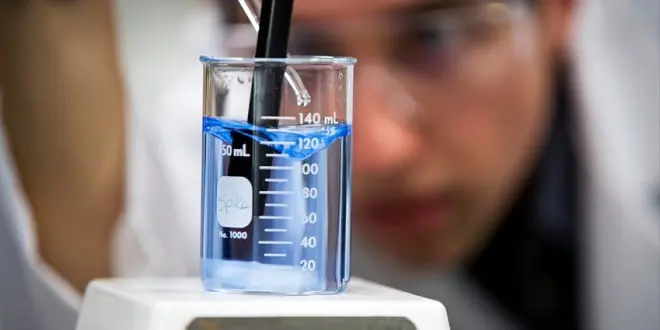Acid-Base Titrations
Titration is an analytical method used to determine the exact amount of a substance by reacting that substance with a known amount of another substance. The completed reaction of a titration is usually indicated by a color change or an electrical measurement. An acid/base neutralization reaction will yield salt and water. In an acid-base titration, the neutralization reaction between the acid and base can be measured with either a color indicator or a pH meter.
Acid + Base Salt + Water
In this experiment, a phenolphthalein color indicator will be used. Phenolphthalein is colorless in acidic solutions and pink in basic solutions. Phenolphthalein is also used in forensic crime scene analysis to detect the presence of blood, Kastle-Meyer test. In the Kastle-Meyer test, hemoglobin catalyzes the oxidation of the colorless form of phenolphthalein to its bright pink form. Four lab periods assigned for this experiment. In part I you will prepare an acid (HCl) solution and a base (NaOH) solution. These solutions will be used for all four periods so it is important to keep these solutions. These solutions will be titrated against each other to obtain a base/acid ratio. In part II you will find the normality of the base solution by titrating it against a solid acid standard. The normality of the acid can be calculated from the normality of the base and the base/acid ratio from part I. In part III the base will be titrated against an unknown acid to find the equivalent weight of the acid. In part IV the equivalent weight of an unknown base will be determined by reacting the unknown base with an excess of HCl and “back-titrating” the left-over acid with NaOH.
Equipment and Reagents (Part I)
6 NHCl 1 Liter plastic bottle 2 beakers (50 mL)
6N NaOH 2 burets 250 mL Erlenmeyer Flask
500 mL Florence Flask Iron stand wash bottle
Distilled water buret clamp phenolphthalein indicator
Stopper(or parafilm) 2 x 50 mL graduated cylinder
Procedure (Part I)
1. Rinse a clean 500 mL Florence flask with a small portion of DI water. Place about 16-17 mL of 6 M or 6 N HCl into the flask and dilute to 500 mL with distilled water. The 500 mL is approximated by bringing the level of the solution up to the point of constriction of the neck of the flask. Stopper the flask and shake to mix. The solution should be approximately 0.2 N HCl. Label the flask with tape.
2. Rinse a clean 1 L plastic bottle with distilled water. Place about 32-34 mL of 6 M or 6 N NaOH into the bottle and dilute to 1 liter with distilled water. Place the cap on the bottle and shake to mix. The solution should be approximately 0.2 N NaOH. Label the bottle with tape.
3. Obtain 2 burets from the stockroom and clamp them onto the ring stand using the buret clamp. Label the buret as acid or base. Label the 50 mL beakers as acid or base. These beakers will be used to transfer the solutions into the burets. Rinse each buret with about 5 mL of DI water and with about 3 x 5 mL of the solution to be used. Fill each buret with the correct solution and flush all of the air bubbles out of the buret tip.
4. Read the initial level of each buret to the nearest 0.02 mL and record this in your notebook. The proper reading is taken from the bottom of the meniscus (see Figure 1 below). If the initial reading is at exactly at zero, then report 0.00 mL.
5. Allow about 25 mL of the acid to run into an Erlenmeyer flask from the acid buret. Record the initial and final readings of this transfer. Calculate the volume of acid transferred by subtracting the final volume reading by the initial volume reading. Your final answer should be to the hundredth place.
6. Add about 20 mL of distilled water into the flask and add 2-3 drops of phenolphthalein indicator. The flask should remain colorless at this point.
7. Record the initial volume of base. Slowly add NaOH from the base buret into the flask with constant swirling. Continue adding base until a very faint color remains. If the color is too bright, add a few drops of acid so that the solution becomes colorless. Add base again to reach the faint end-point. Repeat this process until a faint pink end-point is reached. Record the final volume of base and the initial and final volume of extra acid added to this flask
8. Calculate the total final volume of acid and final volume of base added.
9. From these values, calculate the base to acid ratio:
…




